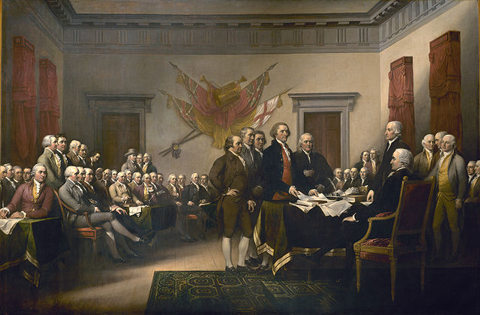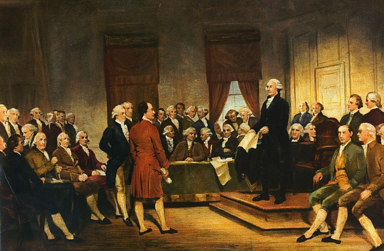We hold these truths to be self-evident, that all men are created equal, that they are endowed by their Creator with certain unalienable Rights, that among these are Life, Liberty and the pursuit of Happiness.
— Declaration of Independence, 1776
 |
|
Thomas Jefferson presented the Declaration of Independence to the Continental Congress in 1776. (Wikimedia Commons) |
When the American colonies broke from England, the Continental Congress asked Thomas Jefferson to write the Declaration of Independence. In the declaration, Jefferson expressed American grievances and explained why the colonists were breaking away. His words proclaimed America’s ideals of freedom and equality, which still resonate throughout the world.
Yet at the time these words were written, more than 500,000 black Americans were slaves. Jefferson himself owned more than 100. Slaves accounted for about one-fifth of the population in the American colonies. Most of them lived in the Southern colonies, where slaves made up 40 percent of the population.
Many colonists, even slave holders, hated slavery. Jefferson called it a “hideous blot” on America. George Washington, who owned hundreds of slaves, denounced it as “repugnant.” James Mason, a Virginia slave owner, condemned it as “evil.”
But even though many of them decried it, Southern colonists relied on slavery. The Southern colonies were among the richest in America. Their cash crops of tobacco, indigo, and rice depended on slave labor. They weren’t going to give it up.
The first U.S. national government began under the Articles of Confederation, adopted in 1781. This document said nothing about slavery. It left the power to regulate slavery, as well as most powers, to the individual states. After their experience with the British, the colonists distrusted a strong central government. The new national government consisted solely of a Congress in which each state had one vote.
With little power to execute its laws or collect taxes, the new government proved ineffective. In May 1787, 55 delegates from 12 states met in Philadelphia. (Rhode Island refused to send a delegation.) Their goal was to revise the Articles of Confederation. Meeting in secret sessions, they quickly changed their goal. They would write a new Constitution. The outline of the new government was soon agreed to. It would have three branches — executive, judiciary, and a two-house legislature.
A dispute arose over the legislative branch. States with large populations wanted representation in both houses of the legislature to be based on population. States with small populations wanted each state to have the same number of representatives, like under the Articles of Confederation. This argument carried on for two months. In the end, the delegates agreed to the “Great Compromise.” One branch, the House of Representatives, would be based on population. The other, the Senate, would have two members from each state.
Part of this compromise included an issue that split the convention on North–South lines. The issue was: Should slaves count as part of the population? Under the proposed Constitution, population would ultimately determine three matters:
(1) How many members each state would have in the House of Representatives.
(2) How many electoral votes each state would have in presidential elections.
(3) The amount each state would pay in direct taxes to the federal government.
 |
|
In 1787 after months of debate, delegates signed the new Constitution of the United States. (Wikimedia Commons) |
Only the Southern states had large numbers of slaves. Counting them as part of the population would greatly increase the South’s political power, but it would also mean paying higher taxes. This was a price the Southern states were willing to pay. They argued in favor of counting slaves. Northern states disagreed. The delegates compromised. Each slave would count as three-fifths of a person.
Following this compromise, another controversy erupted: What should be done about the slave trade, the importing of new slaves into the United States? Ten states had already outlawed it. Many delegates heatedly denounced it. But the three states that allowed it — Georgia and the two Carolinas — threatened to leave the convention if the trade were banned. A special committee worked out another compromise: Congress would have the power to ban the slave trade, but not until 1800. The convention voted to extend the date to 1808.
A final major issue involving slavery confronted the delegates. Southern states wanted other states to return escaped slaves. The Articles of Confederation had not guaranteed this. But when Congress adopted the Northwest Ordinance, it a clause promising that slaves who escaped to the Northwest Territories would be returned to their owners. The delegates placed a similar fugitive slave clause in the Constitution. This was part of a deal with New England states. In exchange for the fugitive slave clause, the New England states got concessions on shipping and trade.
These compromises on slavery had serious effects on the nation. The fugitive slave clause (enforced through legislation passed in 1793 and 1850) allowed escaped slaves to be chased into the North and caught. It also resulted in the illegal kidnapping and return to slavery of thousands of free blacks. The three-fifths compromise increased the South’s representation in Congress and the Electoral College. In 12 of the first 16 presidential elections, a Southern slave owner won. Extending the slave trade past 1800 brought many slaves to America. South Carolina alone imported 40,000 slaves between 1803 and 1808 (when Congress overwhelmingly voted to end the trade). So many slaves entered that slavery spilled into the Louisiana territory and took root.
Northern states didn’t push too hard on slavery issues. Their main goal was to secure a new government. They feared antagonizing the South. Most of them saw slavery as a dying institution with no economic future. However, in five years the cotton gin would be invented, which made growing cotton on plantations immensely profitable, as well as slavery.
The Declaration of Independence expressed lofty ideals of equality. The framers of the Constitution, intent on making a new government, left important questions of equality and fairness to the future. It would be some time before the great republic that they founded would approach the ideals expressed in the Declaration of Independence.
For Discussion and Writing
- What were the ideals of equality expressed in the Declaration of Independence?
- Why was slavery so important to the South?
- Do you think the framers of the Constitution could have limited or banned slavery? Why or why not?
For Further Reading
Horton, James Oliver. Slavery and the Making of America. New York: Oxford University Press. 2005.
Davis, David Brion. Inhuman Bondage: The Rise and Fall of Slavery in the New World. New York: Oxford University Press. 2006.
Berlin, Ira. Many Thousands Gone: The First Two Centuries of Slavery in North America. Cambridge: Harvard College. 1998.

